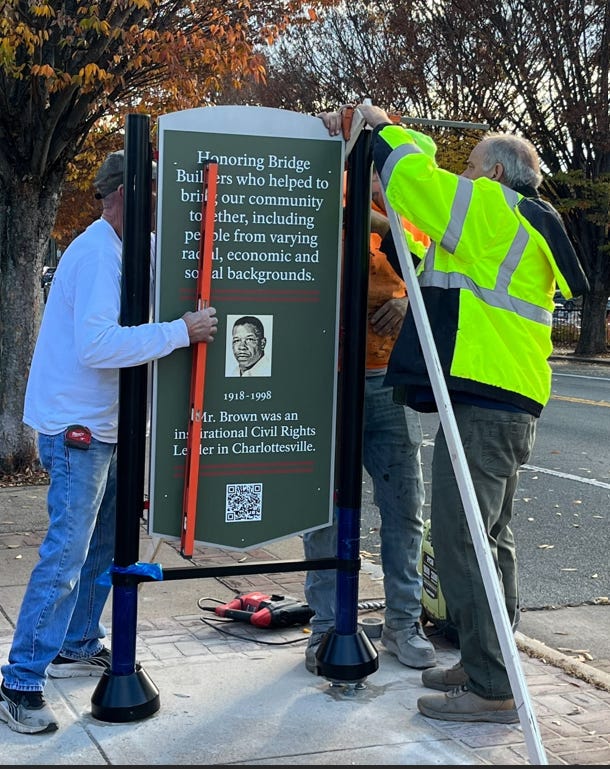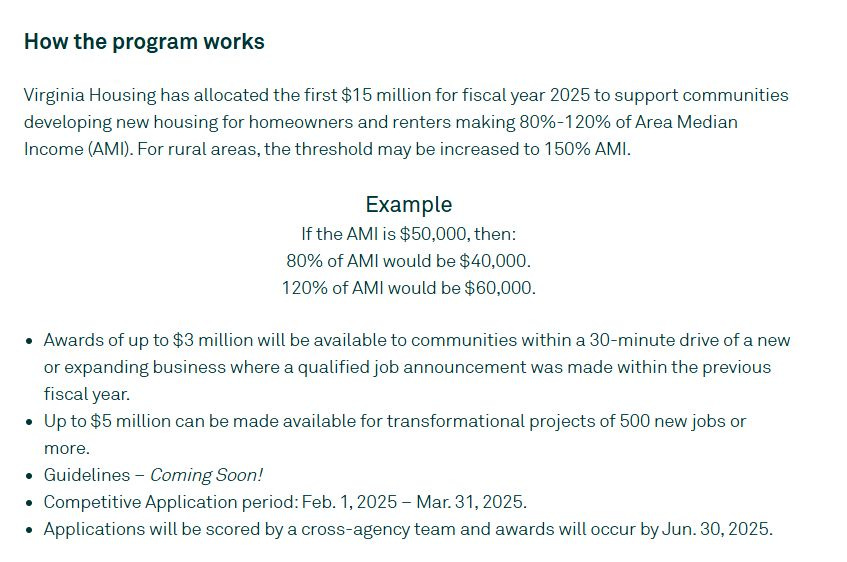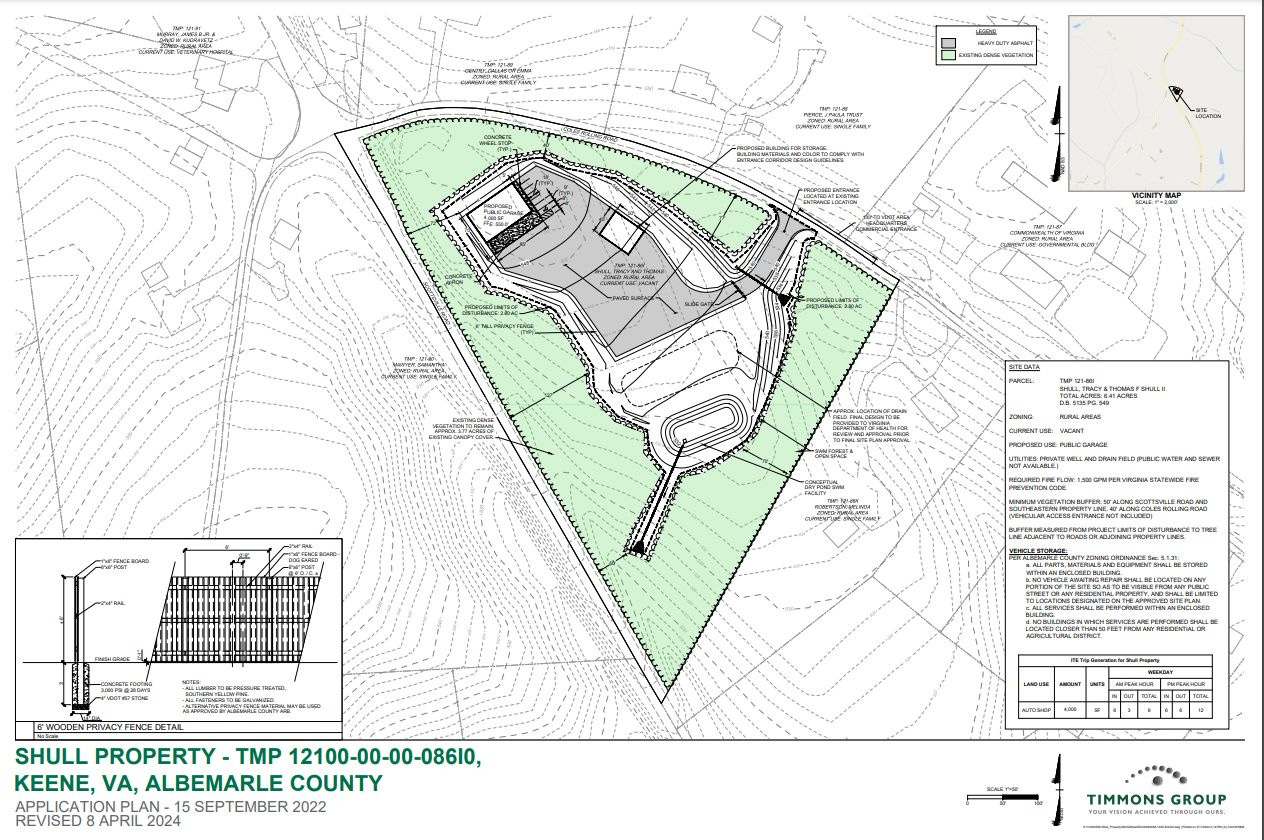November 26, 2024: Albemarle Planning Commission recommends denial of permit for “public garage” in Keene
Plus: Charlottesville informally unveils new signs recognizing Drewary Brown Bridge and 36 other “bridge-builders”
Aside from 1, the number 769 cannot be divided by anything except itself, giving it the definition of prime. This is the 769th edition of Charlottesville Community Engagement, a newsletter and occasional podcast that seeks to tell a few stories about land use, development, and other items of potential importance. Yet there is no scientific proof that this is the actual 769th edition, so it’s probably best to call it the version for November 26, 2024. I’m Sean Tubbs, I suppose its time to get to the research.
In today’s installment:
An infectious disease expert at the University of Virginia says avian influenza is a low risk but that public health scientists are continuing to monitor a handful of human cases
Governor Youngkin issued an executive ordinance earlier this month to tie economic development funding to provision of workforce housing
Work is complete in Charlottesville to refurbish a previous effort to honor “community bridge builders”
Greene County lifts a boil water advisory following a water main break this weekend
The Albemarle Planning Commission has recommended denial of a special use permit for a “public garage” in Keene
First shout-out: Five Things ReLeaf Cville Has Done This Year
In today’s first subscriber-supported shout-out: ReLeaf Cville seeks to help restore the amount of the city that’s covered by trees. This summer they accomplished five things they want people to know about:
Worked in partnership with the Rivanna Conservation Alliance on the third cycle of the Green Team, which teaches young people about the value of trees and the importance of their role in area water quality
Clean Virginia awarded the group $15,000 to enhance education programs to expand the Cville Green Team
That Cville Green Team planted 24 trees in the Woolen Mills earlier this month as part of a goal to plant 135 in the neighborhood
The Virginia Department of Forestry awarded the group $21,410 through the Virginia Trees for Clean Water Program to plant trees in the Woolen Mills neighborhood
ReLeaf was featured on VPM in late June to discuss their work to date (read the report)
Visit their website to find out how you can help!
UVA disease expert says bird flu is currently at low risk for widespread human exposure
The COVID-19 was a transformative event in world history that killed millions and disrupted society as humans across the globe isolated from each other in order to slow the spread while a vaccine was created.
Since then, public health agencies across the world continue to monitor for any sign of future pandemics. In the United States, that work is overseen by the federal Centers for Disease Control and the agency is monitoring the latest strain of avian influenza.
“Since the spring of 2024, sporadic human infections have been reported in the United States. associated with poultry exposures or with dairy cattle exposures associated with the ongoing multi-state outbreaks of HPAI A(H5N1) virus among dairy cattle and poultry,” reads a background section of the CDC’s website.
Most of the human cases are in people who have been exposed to dead animals infected with the virus.
Dr. Patrick Jackson, an infectious disease expert at the University of Virginia Health System, said unless you are in agriculture, there is little risk of being infected.
“What we have seen and continue to see are widespread bird flu in wild birds, more infections occurring in commercial bird flocks and cattle herds, and occasional spillovers into humans that seem limited,” said Dr. Jackson on a health briefing recorded on November 22.
“What we haven't seen is sustained human to human transmission, which would really be the bright red flag that would get you more worried,” Jackson continued.
Dr. Jackson said that all but one of around 50 cases of bird flu in humans can be traced back to some contact with an animal. Surveillance testing and contact tracing are done to identify for certain whether there is the possibility of human to human transmission. He added that prices for poultry and eggs might be affected because of what happens when bird flu strikes a farm.
“This virus does seem to be quite pathogenic in bird flocks,” Jackson said. “And so when you have, you know, a chicken in your flock infected, the response is to cull the entire flock to kind of prevent transmission of this.”
Dr. Jackson said a recent case of a pig being diagnosed with a strain of bird flu seems to have been a dead end for the virus to continue mutating. He said there is no need for most people to be concerned about bird flu at this time, but those who spend time around chickens or turkeys should at least be aware of the virus.
“So if you're turkey hunting or, you know, hunting for waterfowl or things like that, there are specific recommendations from the Virginia Department of Wildlife Resources that you might want to take a look at,” Dr. Jackson said.
The Department of Wildlife Resources notes there is no immediate public health concern regarding avian influenza, but does ask hunters not to process any meat from a bird that may have died from the disease.

Youngkin announces workforce housing initiatives
The cost of housing in Virginia continues to rise and one of the reasons claimed for the continuing increase is the lack of supply in areas where people want to live.
Earlier this month, Governor Glenn Youngkin issued an executive order to create a new initiative to build up to 5,000 units of workforce housing throughout the Commonwealth.
“Maintaining Virginia’s economic growth requires increased housing development, yet the housing market has been constrained by limited supply, burdensome regulations, increasing construction costs, and high interest rates,” reads a section of Executive Order #42.
Citing data compiled by the Virginia Housing and Community Development, the order states that there are around 3.6 million housing units in the Commonwealth but there is a housing demand for at least 4.1 million units.
“For workforce housing specifically, the current estimated shortfall is 41,000 homes,” the order continues.
Some details from the executive order:
The Virginia Economic Development Partnership’s Virginia Business Ready Sites program will begin to require organizations seeking funding to provide a housing plan for any new jobs created.
The order claims that changes to the building codes have reduced the cost of new home construction by $24,000 but the footnote does not cite a specific study.
The order claims that the Virginia Permitting Transparency System created by Executive Order #39 is intended to expedite environmental permits and the order claims those processed by the Department of Environmental Quality are being cleared 70 percent faster than before the beginning of the Youngkin administration. This one points to a dashboard that can be used to track performance.
“Localities, which control zoning and planning, and where control of the vast majority of housing development permits and regulations resides, must drive similar processing time improvements,” the order continues.
The same day that Executive Order #42 was unveiled, Governor Youngkin also announced the the Workforce Housing Investment Program which will be administered by the entity formerly known as the Virginia Housing Development Authority.
“Virginia Housing will provide loans, loan subsidies, and grants up to $3 million to localities and non-profits to develop housing for workers earning 80 to 120 percent of the area median income and 150 percent in rural areas,” reads the order.
To be eligible for the program, a locality must be within a 30 minute drive of a business adding new jobs.
Guidelines for the program are not yet available on the Virginia Housing website. There is a webinar scheduled for December 17 at 2 p.m.
New signs posted on Charlottesville’s Drewary Brown Bridge to honor his legacy and 36 others
In the late 1990’s, Charlottesville replaced a bridge on West Main Street that crosses the railroad tracks. After completion, the new structure was named for Drewary Brown, a civil rights leader who died in 1998.
“Since 2001, 37 plaques have been installed on the bridge honoring Charlottesville citizens who contributed to civil rights, justice, and equality issues and worked to bring our community together, including people from varying racial, economic, and social backgrounds,” reads an information release sent out this morning.

Brown helped create the Monticello Community Action Agency (MACAA) as well as the public defender’s office, according to a website for the Charlottesville Bridge Builders. That’s the organization that has been keeping the memories alive as well as asking City Council to do more to highlight the stories.
New signs have now been installed to draw attention to the plaques which have been reinstalled on a brick wall on the eastern end of the bridge. There will be a formal ceremony in the future, but for now the city has decided to leave the signs uncovered.
The names on the other plaques range from Raymond Lee Bell to Jay Worrall Jr. Bell was the first African-American on the city school board. Worrall was another founder of MACAA. To learn more, take a look at the biographies page on the Cville Bridge Builders website.

Boil alert lifted in Greene County
The Greene County Department of Water and Sewer has lifted a boil water advisory for customers that were put in place on November 22 after a contractor installing fiber optic cable cut a water main in Stanardsville.
“After repairs were made to the broken water main, a series of bacterial samples were collected and sent to a state certified lab,” reads an announcement went out by Greene County this morning. “Both required water samples came back negative for any bacteria.”
Greene County took control over the provision of water and sewer service in 2023 after the Rapidan Service Authority declined to support Greene’s desire to move forward with an expansion of the water supply.
Second shout-out: ACHS taking orders for book profiling local artist Frances Brand
Speaking of Bridge Builders, one of them is Frances Brand. She lived from 1901 to 1990 and in her later life she undertook a series of portraits of individuals from Charlottesville and Albemarle County that would become her Gallery of Firsts.
Brand was a U.S. Army major, a civil rights activist, a world traveler, a devoted churchgoer, and an accomplished artist, among other things. Some remember her as a colorful eccentric who loved to dress in purple, while others knew her as a committed and lifelong social activist.
Behind each of Brand’s portraits of these 20th-century pioneers is a special story. To collect some of them, the Albemarle Charlottesville Historical Society has created a book that features 51 portraits from the full collection of currently known Firsts portraits and share some of the compelling stories about those depicted.
ACHS is taking pre-sale orders now for shipping in November. To place your order, visit the ACHS store.
Albemarle Planning Commission recommends denial of a “public garage” in Keene
For nearly forty-five years, Albemarle County has had strict rules in place that prevent non-agricultural businesses from operating in the rural area. That’s around 95 percent of the locality’s 726 square miles.
Those who wish to operate a business in the rural area do have the right to petition Albemarle’s Board of Supervisors to grant a special use permit.
Such is the case for Thomas and Tracy Shull who have sought to expand their towing business with an automotive repair garage in Keene, an unincorporated community along Route 20 between Charlottesville and Scottsville. The property in question is 6.41 acres in size. A public hearing was held on November 12.
“It is right at the southeast corner of the intersection between Scottsville Road, Coles Rolling Road and Plank Road,” said Cameron Langille, a principal planner with Albemarle County. “There's a variety of surrounding uses in the immediate vicinity of the property. There's the Keene Post Office. There's also the Piedmont Veterinary Service Clinic, the Green Mountain Country Store.”
Under Albemarle’s zoning ordinance, the use requested is that of a “public garage” that Langille said allows for vehicles to be serviced. Body work would not be allowed as that is a separate kind of use.
There was a public hearing for this permit in March at which a dozen people spoke out against the request. The Shulls sought a deferral to allow them to work up a new concept. The resubmission now includes a gate as well as a six foot tall fence.
“The most critical things to talk about in terms of changes from what we saw in March is that there is only 2.8 acres of land disturbance now that has been reduced from 3.02 acres with the original proposal,” Langille said. “Only 1.05 acres of the property will actually be developed for things like building, parking and travel ways.”
Another change is that a series of storage containers would be replaced with an accessory building.
Clint Shifflett of the Timmons Group led the presentation for the Shulls. He said they’ve been trying to reduce the impact the development would have on the landscape and did so again after the deferral in March.
“Tommy and I went back to the drawing board, figured out how can we dial the project back the impact on the site and preserve more buffers and things of that nature,” Shifflett said.
Shifflett also said the Shulls agreed to restricted hours of operation and an agreement that vehicles can only be stored on the property for 30 days. He also said if approved by the Board of Supervisors, the Architectural Review Board would look at the site plan because Route 20 is an entrance corridor. Shifflett also said it was not anticipated this site would be used for the towing business.
“A majority of Tommy's operations for tow service is operated out of his Avon parcel, much closer to town where a vast majority of the towing is taking place,” Shifflett said.
The first speaker at the public hearing was Jerome Beazley who lives across the street.
“The establishment of an auto mechanic shop, hundreds of feet of fencing along Highway 20 and Crow's rolling Road, and a parking lot for industrial equipment, which starkly contrasts with the rural charm of the area, diminishing its character and appeal,” Beazely said.
This same theme came up several times.
“A massive public garage like what was just presented is completely at odds with the pretty community crossroads picture that we have been painted,” said Sarah Sargent of Esmont, the third speaker.
The fifth speaker questioned whether towing vehicles from Charlottesville on Route 20 was a good idea given existing safety concerns with the two-lane road. The seventh speaker made an accusation that Shull just wanted the public garage use to expand the towing business.
“The applicant has a successful towing, impoundment and vehicle storage business on Avon Street Extended, as you know, and he would like to replicate much of that business in Keene,” said Peter Bertone. “But knowing that such a commercial establishment would not be allowed under the regulations in a rural area, the applicant is trying to position the proposed facility as a pro, as a public garage. Do not be fooled. It is no public garage.”
Bertone said there were four other garages in the Keene area, and all of them use less asphalt. He said Shull is seeking to have 40,000 square feet of asphalt as well as a gate for an impoundment lot.
The ninth speaker, Paula Beazley said the community did not want an industrial-sized use in the rural area and the recent construction of the nearby Southern Convenience Center should not be used as a precedent. She said the Planning Commission needed to follow through with the Comprehensive Plan.
“Who will be protecting the interests and voices of The elderly widowed residents having lived there over 50 years with the expectation the rural area zoning will be honored,” Beazley said. “Forfeiting their quiethood to bolster the profits of one man, they will experience a detrimental change in their environment and way of life and certainly interrupt the harmony of the area with the beeping of trucks backing up the ambient noise of a commercial enterprise and trying to avoid them in the 18 wheelers when driving to the Green Mountain store or town for groceries and supplies.”
The public hearing continued with many of the same arguments. But one neighbor spoke out in support of the special use permit because it would provide a service that supports agriculture.
“I would argue that Mr. Shull’s business is actually beneficial to the farms,” said Collins Huff. “I'd much rather have a horse trailer broke down and fixed in Keee than towed all the way up Route 20.”
Huff said he has taken one of his trucks to Shull’s Avon location for service in the past. He was the lone voice in support at a public hearing at which over a dozen people spoke.
At the end of the public hearing, Shiffett said Shull is not under any zoning violations for this property or a nearby parcel he owns.
“We just want to reiterate the intent for the project which is to be able to continue to utilize the Avon facility which has been growing, kind of busting at the seams, to be able to split apart the bulk of the repair work for this location and continue to utilize the Avon site as a quote unquote tow truck depot,” Shifflett said.
Shifflett said the zoning ordinance would allow policing of noise and require screening of vehicles from the roadway. He said he would be willing to add further conditions to ensure the site is not used as an impoundment lot.
Commission Chair Fred Missel said that he and other commissioners take the Comprehensive Plan seriously and urged those who appeared at the public hearing to get involved with the AC44 process.
“I just want to reiterate that that is an incredibly serious and focused point of conversation for us,” Missel said.
Commissioner Lonnie Murray said review of the the rural land use chapter of in the AC44 process is a time to discuss potential new uses that might be allowed. He said this special use permit was a litmus test for the county.
“I think the question is the primary use of this facility to support the rural area,” Murray said. “And I think we heard the applicant say himself, and you're hearing the citizens themselves say that the primary use is not to support them, that the primary use is to support their Charlottesville business.”
Murray said that meant he could not support a recommendation to approve the permit.
Commissioner Luis Carrazana said for him it was a question of scale and if there are to be only three or four cars worked on each day, he was unclear why they needed a space as large as the one proposed.
Commissioner Corey Clayborne said he felt something seemed off about the plan.
To be clear, I have no issue with a four bay garage in the rural area at all,” Clayborne said. “It's more about the scale. And there's something that's not coalescing with me with the visual graphics that I see in the narrative. Something that's just not there. Right. I take my car to NTB, right on Long Street. It looks nothing like that.”
Soon after that comment, the Planning Commission voted on a motion to recommend that the Board of Supervisors deny the permit. The motion passed 6 to 0. Commissioner Julian Bivins was absent.
Reading material for #769
What the Trump administration might mean for the future of the bipartisan infrastructure law, Adie Tomer and Ben Swedberg, Brookings Institute, November 25, 2024
McGuire still hasn’t resigned his state Senate seat weeks after congressional win, Markus Schmidt, Virginia Mercury, November 25, 2024
What the 2024 Election Means for Active Transportation, Joseph Reed, Rails to Trails Conservancy, November 25, 2024
Charlottesville developers still can't find a grocer to fill 501 Cherry project, Emily Hemphill, Charlottesville Daily Progress (paywall), November 25, 2024
There is no more left for #769 to say
First, a correction. There was an error in the 218 West Market Story from the November 22, 2024 edition. The version sent out identified the wrong speaker for the first quote. David Timmerman is the correct member of the BAR. I regret the error.
My correction policy is to update the story with the correct information, leave a comment, and then post this as a note on Substack. Best practice would be to also make a note here which I will add to the policy.
I did not copy this error over to Information Charlottesville which serves as my archive site. That means there’s no need to correct or clarify.
A reality of journalism is that sometimes the first draft is not correct. A reality of my journalism is that there are frequent errors that would be caught by a copy-editor and at some point I will be able to hire someone to do that work.
I’m not there yet, though. Some steps are being made and if I take any downtime this week I will likely spend the time on the business end of this work.
If you’d like to support the business end of this work, consider a paid subscription through Substack. For now, that’s the most effective way of ensuring this keeps going. By the end of the year I may have another option in place.
If you’d like to become a paid Substack supporter, Ting will match your initial payment. If you sign up for service and you are within Ting’s service area, enter the promo code COMMUNITY you’re going to get:
Free installation
A second month for free
A $75 gift card to the Downtown Mall









Hi, Sean, keep an eye on the Drewary Brown bridge sign… The workers installed it right in the middle of the freaking sidewalk and now must move it for ADA compliance. I don’t know what they were thinking, but getting large wheeled luggage past that sign not to mention a wheelchair looks to be pretty tricky!
Two clarifications.
I misspelled one of the planning commissioner's last names and have since changed it.
I also changed the opening line because someone pointed out that 769 could be divided by one as well. That's technically true, but I just assumed that as read. I regret the assumption and apologize I have transformed both you and me.